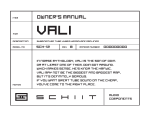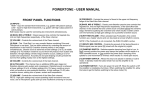Download 009-015-002_rC C-100 User Guide.indd
Transcript
USER GUIDE C-100 Welcome Thank you for making Fishman a part of your acoustic experience. We are proud to offer you the finest acoustic amplification products available: high-quality professional-grade tools which empower you to sound your very best. Troubleshooting If you are unfamiliar with this product, please pay close attention to the requirements for installation. Failure to do so can result in permanent damage to the pickup. Installation by a qualified professional is strongly recommended. Technical support, troubleshooting tips and installation information can be found at http://www.fishman.com/support/ 2 Installation 1. Measure the opening of the bass side wing slot on the bridge with a vernier caliper. The opening should be between .060” and .090” (1.5mm and 2.3mm) for proper fit. If the wing slot opening of the cello measures more than .090” (2.3mm), the leg facing the pickup must be shimmed. For that purpose, we have provided a strip of wooden shim material that can be easily cut with scissors, stacked and glued to produce a shim of any required thickness. 3 2. Slide the transducer into the bass wing slot as shown. Make certain that the sensing element is in contact with the wing face and that the spring (made of tempered beryllium copper) is in contact with the corresponding “leg” face of the bridge. Note: For best performance, the wing slot opening should be .070” (1.8mm). 3. For permanent installation, use any appropriate wood adhesive to bond the shims to the face of the bass side wing. As a result, the shims will be located between the transducer’s sensing element and the bass side wing. Note: The performance of the C-100 is affected by the amount of contact area between its sensing element and the wing face of the bridge. Accordingly, the performance may be adversely affected if the wing face has been stylized or carved in any way. 4 4. Once the transducer is properly inserted into the bridge, the next step is to mount the adhesive-backed jack mount to the back side of the tailpiece. First, peel off the release film from the holder and then press the holder firmly in place below the fine tuning machines of the tailpiece. Position the holder so that the jack, when slipped into the holder, will be at a right angle (90°) to the tailpiece. 5. Insert the jack into the holder and snap shut. Since the wire is somewhat microphonic, it should not be allowed to lie on the face of the instrument. 5 Fine Tuning Once the C-100 is properly mounted, plug the instrument into an amplifier and play at a low volume. Carefully shift the position of the C-100 within the slot and listen for the best location. Note: If installation is to be permanent, a small drop of cyanoacrylate adhesive on the spring side (lower face) of the transducer can be used. 6 Plugging In An impedance matching preamp is recommended, but not required. This will help realize the full frequency response potential of the pickup and allow for cable runs longer than 10 feet without signal deterioration. Use a high quality, low capacitance ¼” shielded instrument cable. This will ensure minimal tone coloration and hum. 7 WWW.FISHMAN.COM 009-015-002 Rev C 4-09















